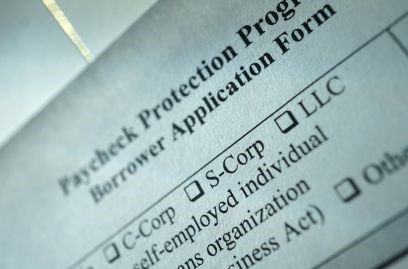
Key Updates of the Consolidated Appropriations Act, 2021
On December 27, 2020, President Trump signed into law the Consolidated Appropriations Act, 2021. Below you will find some of the key updates of this new Act, which include clarification of the Paycheck Protection Program (PPP) that resulted from the CARES Act, as well as details of the second round of the Paycheck Protection Program. Updates to the original CARES Act Paycheck Protection Program are referred to as PPP1, and details of the second round of the Paycheck Protection Program are referred to as PPP2.
Expansion & Modification of the Paycheck Protection Program:
- This new Act allows businesses to deduct expenses paid with forgiven PPP loans.
- Gross income does not include forgiveness of certain loans, emergency Economic Injury Disaster Loan grants, and certain loan repayment assistance, each as provided by the CARES Act.
- Deductions are allowed for otherwise deductible expenses paid with the amounts not included in income by this section.
- Tax basis will not be reduced as a result of the exclusion of those amounts from gross income.
Paycheck Protection Program Eligibility:
- PPP2 loans will be available to first-time qualified borrowers and to businesses that previously received a PPP loan.
- Previous PPP recipients may apply for another loan of up to $2 million, provided they:
- Have 300 or fewer employees;
- Have used or will use the full amount of their first PPP loan; and
- Can show a 25% gross revenue decline in any 2020 quarter compared with the same quarter in 2019.
- PPP2 will permit first-time borrowers from the following groups:
- Businesses with 500 or fewer employees that are eligible for other SBA 7(a) loans;
- Sole proprietors, independent contractors, and eligible self-employed individuals;
- Not-for-profits, including churches; and
- Accommodation and food services operations (those with North American Industry Classification System codes starting with 72) with fewer than 300 employees per physical location.
- Borrowers that returned all or part of a previous PPP loan may reapply for the maximum amount available to them.
Paycheck Protection Program Loan Terms:
- Like PPP1, the costs eligible for loan forgiveness in PPP2 include payroll, rent, covered mortgage interest, and utilities. PPP2 also makes the following potentially forgivable:
- Covered property damage costs related to property damage and vandalism or looting due to public disturbances in 2020 that were not covered by insurance or other compensation;
- Covered worker protection and facility modification expenditures, including personal protective equipment, to comply with COVID-19 federal health and safety guidelines;
- Expenditures to suppliers that are essential at the time of purchase to the recipient’s current operations;
- Covered operating costs, such as software and cloud computing services and accounting needs.
- To be eligible for full loan forgiveness, PPP borrowers must spend no less than 60% of the funds on payroll over a covered period of either 8 or 24 weeks. These are the same parameters PPP1 had when it stopped accepting applications in August.
- PPP borrowers may receive a loan amount of up to 2.5 times their average monthly payroll costs in the year prior to the loan or the calendar year, the same as with PPP1. However, the maximum loan amount has been cut from $10 million in the first round to the previously mentioned $2 million maximum. PPP borrowers with NAICS codes starting with 72 (hotels and restaurants) can get up to 3.5 times their average monthly payroll costs but are subject to a $2 million maximum.
Simplified Application and Other Terms of Note:
- The Consolidated Appropriations Act, 2021 creates a simplified forgiveness application process for loans of $150,000 or less. A borrower shall receive forgiveness if a borrower signs and submits to the lender a certification that is not more than one page in length, includes a description of the number of employees the borrower was able to retain because of the loan, the estimated total amount of the loan spent on payroll costs, and the total loan amount. The SBA must create the simplified application form within 24 days of the bill’s enactment and may not require additional materials unless necessary to substantiate revenue loss requirements or satisfy relevant statutory or regulatory requirements. Borrowers are required to retain relevant records related to employment for four years and other records for three years, as the SBA may review and audit these loans to check for fraud.
- The Consolidated Appropriations Act, 2021 repeals the requirement that PPP borrowers deduct the amount of any EIDL advance from their PPP forgiveness amount.
- The Consolidated Appropriations Act, 2021 includes set-asides to support first- and second-time PPP borrowers with 10 or fewer employees, first-time PPP borrowers that have recently been made eligible, and for loans made by community lenders.
Paycheck Protection Program Deductibility:
- Section 276 of the Consolidated Appropriations Act, 2021 provides that for purposes of the Internal Revenue Code of 1986:
- (1) no amount shall be included in the gross income of the eligible recipient by reason of forgiveness of indebtedness described in subsection (b),
- (2) no deduction shall be denied, no tax attribute shall be reduced, and no basis increase shall be denied, by reason of the exclusion from gross income provided by paragraph (1), and
- (3) in the case of an eligible recipient that is a partnership or S corporation-
- (A) any amount excluded from income by reason of paragraph (1) shall be treated as tax exempt income for purposes of sections 705 of the Internal Revenue Code of 1986, and
- (B) except as provided by the Secretary of the Treasury (or the Secretary’s delegate), any increase in the adjusted basis of a partner’s interest in a partnership under section 705 of the Internal Revenue Code of 1986 with respect to any amount described in subparagraph (A) shall equal the partner’s distributive share of deductions resulting from costs giving rise to forgiveness described in subsection (b).
As for basis, Sec. 276 of the Consolidated Appropriations Act, 2021 provides that “the amendment made by this subsection shall apply to taxable years ending after the date of the enactment of the CARES Act,” so the basis step up likely can occur for the 2020 taxable year.
Payroll Tax Credits:
- The Consolidated Appropriations Act, 2021 extends the refundable payroll tax credits for paid sick and family leave through the end of March 2021. To compute the credit, individuals may elect to use their average daily self-employment income from 2019 rather than 2020.
Employer-Provided Student Loan Repayment:
- The CARES Act temporarily allowed employers to provide student loan repayment as a benefit to employees through December 31, 2020. Under the provision, an employer may contribute up to $5,250 annually toward an employee’s student loans, and such payment would be excluded from the employee’s income. The $5,250 cap applies to both the new student loan repayment benefit as well as other educational assistance (e.g., tuition, fees, books) provided by the employer under current law. The provision is extended through December 31, 2025.
Employee Payroll Tax Deferral:
- An employer’s repayment period for the payment of social security taxes on wages paid to employees earning under $4,000 bi-weekly is extended from April 2021 through December 31, 2021.
Employee Retention Tax Credit:
- The Consolidated Appropriations Act, 2021 extends the CARES Act employee retention tax credit (ERTC) through June 30, 2021.
- The Consolidated Appropriations Act, 2021 includes certain modifications to the ERTC, such as:
- An increase in the credit rate from 50% to 70% of qualified wages;
- An increase in the limit on per employee creditable wages from $10,000 for the year to $10,000 for each quarter;
- A reduction in the required year-over-year gross receipts decline from 50% to 20%; and
- A safe harbor allowing employers to use prior-quarter gross receipts to determine eligibility.
- The Consolidated Appropriations Act, 2021 also (retroactive to the effective date of the CARES Act):
- Provides that employers who receive PPP loans may still qualify for the ERTC with respect to wages that are not paid with forgiven PPP proceeds;
- Clarifies the determination of gross receipts for certain tax-exempt organizations; and
- Clarifies that group health plan expenses can be considered qualified wages even when no other wages are paid to the employee, consistent with IRS guidance.
Deduction for Business Meal Expenses:
- Businesses may deduct up to 100% of the costs of business meals, so long as the expense is for food or beverages provided by a restaurant.
- Applies to expenses incurred after December 30, 2020 and expires at the end of December 2022.
Child Tax Credit (CTC) & Earned Income Tax Credit (EITC):
- The Consolidated Appropriations Act, 2021 provides that to calculate the CTC and EITC for the 2020 year, an individual may use their 2019 income to determine his or her eligibility for the 2020 tax year.
Charitable Contributions:
- The $300 charitable deduction for non-itemizers is extended through 2021, and married couples filing jointly may deduct up to $600. However, the penalty for taxpayers who overstate the deduction is increased from 2% to 50% of the underpayment.
Temporary Special Rules for FSAs:
- Taxpayers may roll over unused amounts in their health and dependent care flexible spending arrangements from 2020 to 2021 and from 2021 to 2022. Employers may allow employees to make a 2021 midyear prospective change in contribution amounts.
If you have any questions regarding this legislation or would like more information about making the most of your PPP loan, please contact us at 404-255-7400 or info@hoffmanestatelaw.com.
Author
Recent Posts
What Divorce Really Does to Your Estate Plan (Hint: Not Enough)
Unmarried? Estate Planning is Even More Important for You
Are You A Digital Nomad?
All Categories
Get a Free Consultation
Call us today to discuss your issue.



